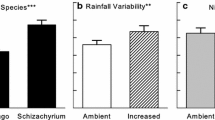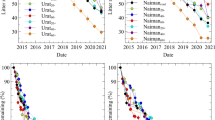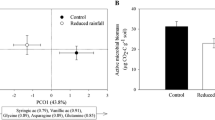Summary
We tested the hypotheses that rates of decomposition in a desert should be higher following single large rain events of 25 mm than evenly spaced 6 mm events and that supplemental rainfall should result in higher populations of soil biota. There were no significant differences in mass losses of creosotebush, Larrea tridentata, leaf litter on plots receiving water supplementation and no added water. On some sampling dates, there were higher mass losses in the 6 mm·week-1 treatment. Weekly rainfall produced higher coefficients of variation in mass losses than the other rainfall regimes. A single event pulse compared with weekly pulses of rainfall during the normal “dry” period resulted in no differences in mass losses. Microarthropods and nematodes exhibited numerical responses to supplemental rainfall but the litter microflora did not. These studies provide direct experimental evidence that the conventional wisdom linking decomposition to rainfall in deserts is wrong. The studies also suggest that the effects of litter fauna on surface litter decomposition are minimal; therefore, future studies should focus on activites of the microflora.
Similar content being viewed by others
References
Babuick LA, Paul EH (1970) The use of flourescein iso-thiocyanate in the determination of the bacterial biomass in grassland soil. Canadian J Microbiol 16:57–62
Beathey JC (1974) Phenological events and their environmental triggers in Mojave desert ecosystems. Ecology 55:856–863
Coolen WA (1979) Methods for the extraction of Meloidogyne spp. and other nematodes from roots and soil. In: Root-Knot Nematodes (Meloidogyne species). Systematics, Biology and Control, Lamberti F, Taylor CE (eds) Academic Press, NY, pp 317–329
Cutler DW (1920) A method for estimating the number of active protozoa in the soil. J Agric Sci 10:135–143
Elkins NZ, Whitford WG (1982) The role of microarthropods and nematodes in decomposition in a semi-arid ecosystem. Oecologia (Berlin) 55:303–310
Elkins NZ, Steinberger Y, Whitford WG (1982) Factors affecting the applicability of the AET model for decomposition in arid environments. Ecology 63:579–580
Elliot ET, Coleman DC (1977) Soil protozoan dynamics in a short grass prairie. Soil Biol Biochem 6:113–118
Houghton FE (1972) Climatic Guide, New Mexico State University, Las Cruces, New Mexico 1851–1971. New Mexico State Univ Agric Res Dept 230:1–20
Louw GN, Seely MK (1982) Ecology of Desert Organisms. Longman, London, p 194
Meentemeyer V (1978) Macroclimate and lignin control of litter decomposition rates. Ecology 59:465–472
Noy Meir I (1973) Desert ecosystems: Environment and producers. Ann Ev Ecol Syst 4:25–51
Olsen FCW (1950) Quantitative estimates of filamentous algae. Trans Amer Micros Soc 59:272–292
Santos PF, Elkins NZ, Steinberger Y, Whitford WG (1984) A comparison of surface and buried Larrea tridentata leaf litter decomposition in North American hot deserts. Ecology 65:278–284
Schaefer D, Steinberger Y, Whitford WG (1985) The failure of nitrogen and lignin control of decomposition in a North American desert. Oecologia (Berlin) (in press)
Singh BN (1946) A method of estimating the numbers of soil protozoa, especially amoebae, based on their differential feeding on bacteria. Ann Appl Biol 33:112–119
Sokal RR, Rohlf FS (1969) Biometry, San Francisco, WH Freeman and Co.
Tevis L Jr (1958) Germination and growth of ephemerals induced by sprinkling a sandy desert. Ecology 39:681–688
Went FW (1949) Ecology of desert plants. II. The effect of rain and temperature on germination and growth. Ecology 30:1–13
Whitford WG, Meentemeyer V, Seastedt TR, Cromack K Jr, Crossley DA, Santos P, Todd RL, Waide JB (1981) Exceptions to the AET model: deserts and clear-cut forests. Ecology 62:275–277
Author information
Authors and Affiliations
Rights and permissions
About this article
Cite this article
Whitford, W.G., Steinberger, Y., MacKay, W. et al. Rainfall and decomposition in the chihuahuan desert. Oecologia 68, 512–515 (1986). https://doi.org/10.1007/BF00378764
Received:
Issue Date:
DOI: https://doi.org/10.1007/BF00378764




